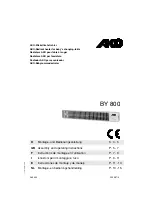
quesTIons & answers
Occasionally the cover is hard to open or close. What causes this? What should I do?
In order for pressure to build inside your pressure cooker, the unit has a special cover which provides an airtight fit. Because
of this, you may find that on occasion the cover may be difficult to open or close. The following suggestions will help if this
happens:
If the cover seems hard to close, press the palm of your hand on the cover area
directly opposite the cover handle while moving the cover handle to the closed
position with your other hand.
If, after browning meat or poultry, the cover is difficult to close, it may be due
to expansion of the pressure cooker body from heating. Remove the cover and
allow the pressure cooker body to cool slightly and try again. Do not place the
pressure cooker back on the burner until it is fully closed.
If necessary, to help make the cover easier to open and close, a very light coat-
ing of cooking oil may be applied to the sealing ring and to the underside of the
lugs on the pressure cooker body (Fig. O). Use a pastry brush, a piece of cloth,
or your fingertips and be sure to wipe off any excess oil.
What can be done if the food prepared in the pressure cooker has more liquid than desired?
Simmer to evaporate the excess liquid. Next time you prepare the same recipe, you may want to use less liquid.
How does one prevent overcooking?
Remember to begin timing as soon as the pressure regulator begins to rock gently. It is very important to accurately time the
cooking period. A Presto
kitchen timer is very helpful for this purpose. Also be sure to follow the recipe instructions for
cooling the pressure cooker.
What if the food is not completely done after the recommended cooking time?
Simply bring the cooker back up to pressure and cook the food a minute or two longer.
Can I use my aluminum pressure cooker on all types of ranges?
Your pressure cooker will work on gas, electric coil and ceramic glass (smoothtop) ranges. In addition, stainless steel pres-
sure cookers will work on induction ranges.
When cooking first begins, is it normal for steam to escape and moisture to form on the cover and between the han-
dles?
It is normal for steam to escape and a slight amount of moisture leakage to form on the cover and between the handles when
cooking first begins. If leakage continues, the cover handle may not be properly aligned with the body handle and, therefore,
the cover lock cannot engage.
Is it normal for the air vent/cover lock to rise up partially and drop back down when cooking first begins?
It is possible that the air vent/cover lock will move up and down slightly when cooking first begins. Do not be concerned.
The air vent/cover lock will remain in the up position once the cooker has sealed. However, if the air vent/cover lock con-
tinues to move up and down or rises partially, tap it lightly with the tip of a knife. If it does not rise once you have tapped
it, the following may be occurring:
1. The burner is not hot enough.
2. The cooker is not fully closed (see page 4).
3. There is insufficient liquid to form steam.
4. The gasket for the air vent/cover lock needs to be replaced (see page 6).
Apply
Cooking
Oil Here
Fig . O
Apply Cooking
Oil Here
9










































